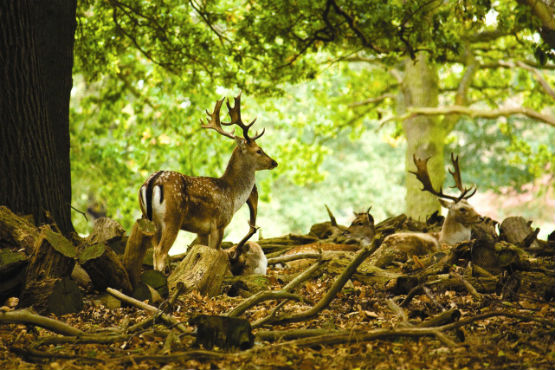August is a month of two halves, Peter Jones considers how deer change their behaviour in the month ahead.

("Whilst deer are uncharacteristically visible during their off season, they appear to vanish as soon as the open season arrives!")
Honey has for centuries formed an important part of human nutrition. As such there exists a huge body of knowledge and analysis surrounding the humble honey bee. The reoccurring theme that laces through much of this research, recognises the astonishing amount of sophisticated, inherited knowledge that, in an insect that has the brain the size of a pin head, is congenital.
Why am I talking about bees and what on earth is the relevance of this to August and deer?
Well in England & Wales August marks the point at which the males of the herding species once again come into season. However, how often have you heard a stalker remark that whilst deer are uncharacteristically visible during their off season, they appear to vanish as soon as the open season arrives! Can it be that a deer’s brain, like that of the bee, comes factory loaded with inherited knowledge of its open season?
Before you email me with howls of derision, it is worth noting a recent report by the Wall Street Journal (2009) and more recently the Guardian (2014), which refers to a report from Germany, where it has been found that in the 25 years since the fall of the Berlin Wall, deer will still not venture across the boundary, despite there being no physical representation of the barrier.
The wall was first constructed in 1961 and so it occurs to me, if deer were able to form a collective and lasting wisdom within such a relatively short space of time, it is possible, indeed likely, that in the decades since the Deer Act, deer, like the bee, have, in their larger more complex brains, laid down a genetic memory that has imparted a congenital gift on future generations informing them of the most perilous times of year. This in turn better enables the species as a whole to mitigate danger.
Clearly there are many variables at stake, including the undeniably crucial aspect of learned behaviour, however, it is worth a thought the next time an open season arrives and the deer that once were visible, seemingly dissolve into the woods in anticipation of your inevitable pursuit!
Whatever your thoughts on the matter, in England & Wales August can be seen as a month of two halves, during the first half our attention remains focused on Roe Buck, however as the Roe rut fizzles and the Roe Buck collapse exhausted into inactivity, stalkers who are fortunate enough to have a variety of species on their ground, turn their focus to the management of the larger herding deer.
In Scotland the Stags will of course, have been in season since July, and with the season not properly hotting up until September, it is common for managers to be carrying out some early culling of the poorer males during August.
On to this month’s film, and this time we have a choice for you. Considering I am penning this during the Roe Rut we have included our film ‘How to Call a Roe Buck’ in order to provide a few tips on calling: youtube Alternatively if you have seen this film, we have somewhat of a ‘one off’ for you in the form of ‘Rhino Vita Dart hunting’. This comes courtesy of the Capreolus Club. Whether Africa is your thing or not, there is some superb rare footage of Rhino which I hope you’ll appreciate: youtube
 IN Season in England & Wales: Roe Buck, Fallow Buck, Red & Sika Stags, Muntjac Bucks & Muntjac Does.
IN Season in England & Wales: Roe Buck, Fallow Buck, Red & Sika Stags, Muntjac Bucks & Muntjac Does.
OFF Season in England & Wales: Roe Does, Fallow Does, Sika Hinds, Red Hinds, CWD Bucks & CWD Does.
IN Season in Scotland: Roe Buck, Red Stags, Sika Stags, Fallow Buck.
OFF Season in Scotland: Roe Does, Fallow Does, Sika Hinds, Red Hinds.
(Peter Jones - Editor)



















